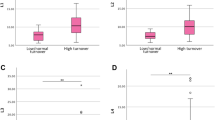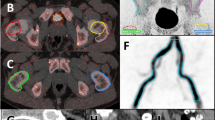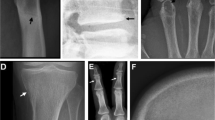Abstract
In this preliminary study plasma osteocalcin levels and Tc-99m-HMDP (Technetium 99m hydroxymetylene diphosphonate) bone uptake (BU) were measured in 10 chronic end-stage renal failure patients who were on maintenance hemodialysis. The aim of this study was to determine the correlation between bone uptake and osteocalcin-a sensitive and specific marker of osteoblastic activity. There was a statistically significant increase in both 20 and 180 minute uptake in the patient group (36±2.7 and 39±3.6) when compared to the normal volunteers (32±3.1 and 19±2.7). Plasma osteocalcin levels were also significantly high (24.5±5.6 ng/ml) when compared with normal values (6.5±2.3 ng/ml). The correlations between osteocalcin and 20 and 180 min BU were high (r=0.62 and 0.72 respectively). In conclusion, our preliminary study suggests that, in hemodialysis patients, Tc-99m-HMDP bone uptake quantification is a sensitive and non-invasive method for showing increased osteoblastic activity.
Similar content being viewed by others
References
Malluche HH, et al: The value of bone biopsies for diagnosis of renal bone disease. Dialysis Transplantation.Nephrology, pp 111–115, 1973
Sebert JL, et al: Plasma Bone-GLA Protein: Assessment of its clinical value as an index of bone turnover and bone formation in hemodialysis patients.Proc EDTA-ERA 22: 1218, 1985
Malluche HH, et al: Plasma levels of bone GLA-protein reflect bone formation in patients on chronic maintenance dialysis.Kidney Int 26: 869, 1984
Hauschka PV, Reid ML: Vitamin K dependence of a calcium binding protein containing gamma-carboxy-glutamic acid in chicken bone.J Biol Chem 253: 9063, 1978
Rosenthall L, Kaye M: Technetium-99m-pyrophosphate kinetics and imaging in metabolic bone disease.J Nucl Med 16: 33, 1975
Wiegmann T, Rosenthall L, Kaye M: Technetium-99m-pyrophosphate bone scans in hyperparathyroidism.J Nucl Med 18: 231, 1977
Ling G, Nebel G, Dorr S: Die Bedeutung der Szintimetrie im Vergleich mit Histomorphometrie, Parathormon, Densitometrie und Rontgendiagnostik bei renaler Ostheopathie.Fortschr Geb Rontgenstr Nuklearmed Erganzungsband 136: 9, 1981
Fogelman I, Bessent RG, Turner JG, et al: The use of whole-body retention of Tc-99m diphosphonate in the diagnosis of metabolic bone disease.J Nucl Med 19: 270, 1978
De Graaf P, Pauwels EKJ, Vos PH, et al: Observations on computerized quantitative bone scintigraphy in renal osteodystrophy.Eur J Nucl Med 9:419, 1984
Jones AG, Francis MD, Davis MA: Bone scanning: Radionuclidic reaction mechanisms.Semin Nucl Med 6: 3, 1976
Francis MD, Russel RGG, Fleisch H: Diphosphonates inhibition formation of calcium phosphate crystalsin vitro and pathological calcificationin vivo Science 165: 1264, 1969
Rosenthall L, Kaye M: Observations on the mechanism of Tc99m-labeled phosphate complex uptake in metabolic bone disease.Semin Nucl Med 6: 59, 1976
Guillemart A, Besnard JC, LePape A: Skeletal up-take of pyrophosphate labeled with technetium-95m and technetium-96, as evaluated by autoradiography.J Nucl Med 19: 895, 1978
Zimmer AM, Isitman AT, Holmes RA: Enzymatic inhibition of diphosphonate: A proposed mechanism of tissue uptake.J Nucl Med 16: 352, 1975
Beresford JN, Gallagher JA, Poser JV, et al: Production of osteocalcin by human bone cellsin vitro: Effects of 1,25(OH)2D3, 24,25(OH)2D3, parathyroid hormone, and glucocorticoids.Metab Bone Dis Rel 5: 229, 1984
Lian JB, Couttes MC, Canalis E: Studies of hormonal regulation of osteocalcin synthesis in cultured fetal rat calvaria.J Biol Chem 260: 8706, 1985
Brown JP, Delmas PD, Malaval L, et al: Serum bone Glaprotein: A specific marker for bone formation in postmenopausal osteoporosis.Lancet 1: 1091, 1984
Ismail F, Epstein S, Pacifici R, et al: Serum bone GLA protein (BGP) and other markers of bone mineral metabolism in postmenopausal osteoporosis.Calcif Tissue Int 39: 230, 1986
Author information
Authors and Affiliations
Rights and permissions
About this article
Cite this article
Karayalcin, U., Karayalcin, B., Yakupoglu, G. et al. Tc-99m-HMDP bone uptake quantification and plasma osteocalcin levels in hemodialysis patients—A preliminary study. Ann Nucl Med 6, 9–12 (1992). https://doi.org/10.1007/BF03164636
Received:
Accepted:
Issue Date:
DOI: https://doi.org/10.1007/BF03164636




